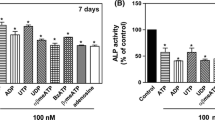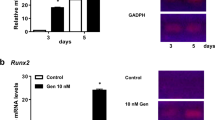Summary
L-ascorbic acid at physiological concentrations (10 μg/ml) increased alkaline phosphatase activity in the osteoblastlike rat osteosarcoma cell line, UMR-106. The increase was dose-dependent and detectable at 6 hours after the addition of 100 μg/ml ascorbic acid to the medium. Treatment of the cells with 100 μg/ml ascorbic acid potentiated the response of cAMP to both PTH and PGE1, while cell growth was inhibited. Furthermore, the number of colonies formed by the cells grown, in the soft agar was significantly reduced by increasing concentrations of ascorbic acid. These results indicate that ascorbic acid might play some role in the differentiation of osteoblasts.
Similar content being viewed by others
References
Barnes MJ (1975) Function of ascorbic acid in collagen metabolism. Ann NY Acad Sci 258:264–277
Peterkofsky B (1972) The effect of ascorbic acid on collagen polypeptide synthesis and proline hydroxylation during the growth of cultured fibroblasts. Arch Biochem Biophys 152:318–328
Chen TL, Raisz LG (1975) The effects of ascorbic acid deficiency on calcium and collagen metabolism in cultured fetal rat bones. Calcif Tissue Res 17:113–127
Chojkier M, Spanheimer R, Peterkofsky (1983) Specifically decreased collagen biosynthesis in scurvy dissociated from an effect on proline hydroxylation and correlated with body weight loss. In vitro studies in guinea pig calvarial bones. J Clin Invest 72:826–835
Partridge NC, Frampton RJ, Eisman JA, Michelangeli VP, Elms E, Bradley TR, Martin TJ (1980) Receptors for 1,25(OH)2 vitamin D3 enriched in cloned osteoblast-like rat osteogenic sarcoma cells. FEBS Lett 115:139–142
Partridge NC, Alcorn D, Michelangeli VP, Ryan G, Martin TJ (1983) Morphological and biochemical characterization of four clonal osteogenic sarcoma cell lines of rat origin. Cancer Res 43:4308–4314
Bessey OA, Lowry OH, Brock, MJ (1946) A method for the rapid determination of alkaline phosphatase with five cubic millimeters of serum. J Biol Chem 164:321–329
Lowry OH, Resebrough NJ, Farr AL, Randall RJ (1951) Protein measurement with the folin phenol reagent. J Biol Chem 193:265–275
Steiner AL, Kipnis DM, Utiger R, Parker C (1969) Radioimmunoassay for the measurement of adenosine-3′, 5′-cyclic phosphate. Proc Natl Acad Sci USA 64:367–373
Macpherson I, Montagnier L (1964) Agar suspension culture for the selective assay of cells transformed by polyoma virus. Virology 23:291–294
Feng J, Melcher AH, Brunette DM, Moe HK (1977) Determination of L-ascorbic acid levels in culture medium: concentrations in commercial media and maintenance of levels under conditions of organ culture. In Vitro 13:91–99
Mohberg J, Johnson MJ (1963) Stability of vitamins in a chemically defined medium for 929-L fibroblasts. J Natl Cancer Inst 31:603–610
Luben RA, Wong GL, Cohn DV (1976) Biochemical characterization with parathormone and calcitonin of isolated bone cells: provisional identification of osteoclasts and osteoblasts. Endocrinology 99:526–534
Murad S, Grove D, Lindberg KA, Reynolds G, Sivarajah A, Pinnell SR (1981) Regulation of collagen synthesis by ascorbic acid. Proc Natl Acad Sci USA 78:2879–2882
Majeska RJ, Rodan GA (1982) The effect of 1,25(OH)2D3 on alkaline phosphatase in osteoblastic osteosarcoma cells. J Biol Chem 257:3362–3365
Zull JE, Krug S, Abel D, Caplan AI (1978) Development of parathyroid hormone- and calcitonin-activated adenylate cyclases in embryonic chicken limb and in cultured cells from embryonic chicken limb. Proc Natl Acad Sci USA 75:3871–3875
Wong GL, Lukert BP, Adams JS (1980) Glucocorticoids increase osteoblast-like bone cell response to 1,25(OH)2D3. Nature 285:254–257
Hall BR (1981) Modulation of chondrocyte activity in vitro in response to ascorbic acid. Acta Anat 109:51–63
Park CH, Amare M, Savin MA, Hoogstraten B (1980) Growth suppression of human leukemic cells in vitro by L-ascorbic acid. Cancer Res 40:1062–1065
Linkhart TA, Clegg CH, Hauschka SD (1981) Myogenic differentiation in permanent clonal mouse myoblast cell lines: regulation by macromolecular growth factors in the culture medium. Dev Biol 86:19–30
Kaufman SJ, Parks CM (1977) Loss of growth and differentiation in the fu-1 variant of the L8 line of rat myoblasts. Proc Natl Acad Sci USA 74:3888–3892
Green H, Kehinde O (1976) Spontaneous heritable changes leading to increased adipose conversion in 3T3 cells. Cell 7:105–113
Benade L, Howard T, Burk D (1969) Synergistic killing of Ehrlich ascites carcinoma cells by ascorbate and 3-amino-1,2,4-triazole. Oncology (Basel) 23:33–43
Josephy PD, Palcic B, Skarsgard LD (1978) Ascorbate-enhanced cytotoxicity of misomidazole. Nature 271:370–372
Koch CJ, Biaglow JE (1978) Toxicity, radiation sensitivity modification and metabolic effects of dehydroascorbate and ascorbate in mammalian cells. J Cell Physiol 94:299–306
Author information
Authors and Affiliations
Rights and permissions
About this article
Cite this article
Sugimoto, T., Nakada, M., Fukase, M. et al. Effects of ascorbic acid on alkaline phosphatase activity and hormone responsiveness in the osteoblastic osteosarcoma cell line UMR-106. Calcif Tissue Int 39, 171–174 (1986). https://doi.org/10.1007/BF02555114
Received:
Revised:
Issue Date:
DOI: https://doi.org/10.1007/BF02555114




